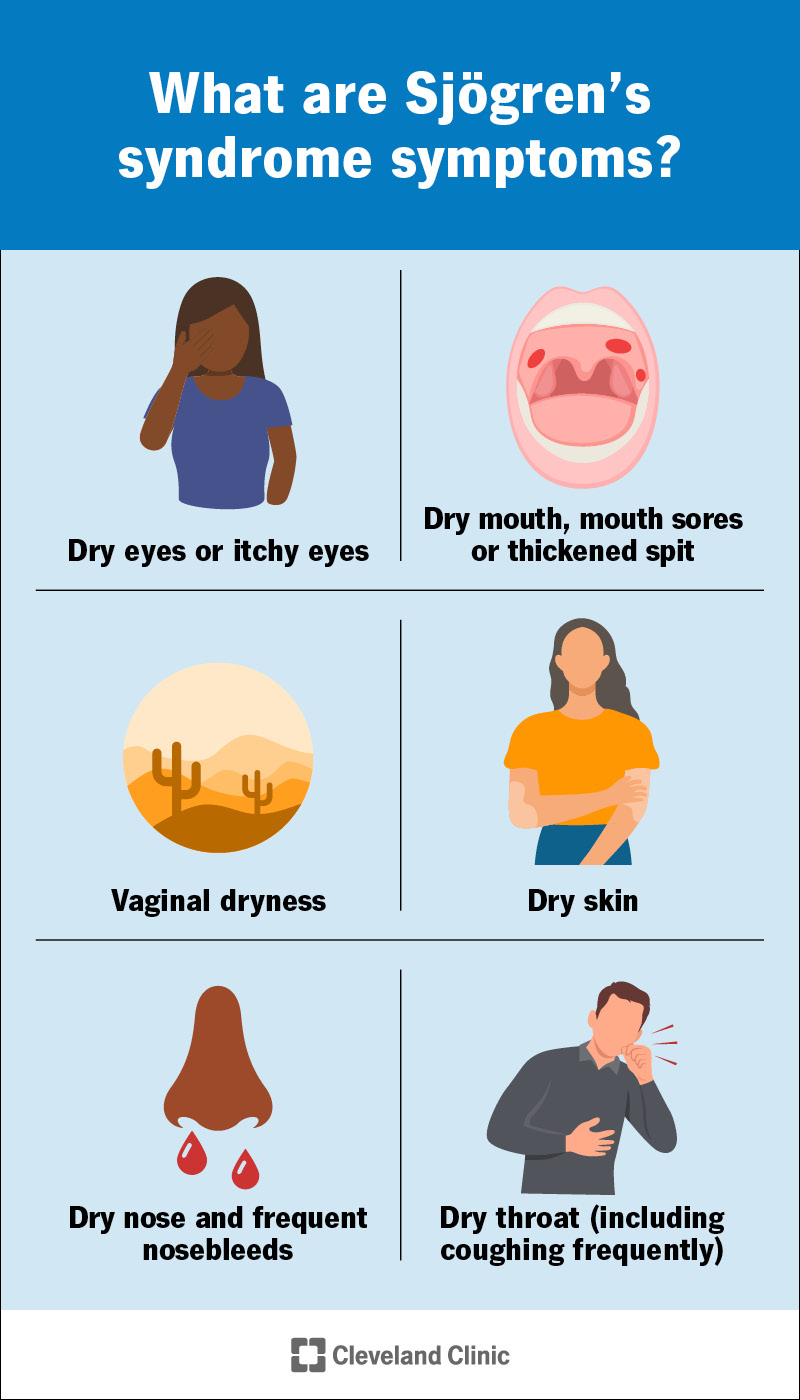Sjögren’s syndrome is an autoimmune disease that happens when your immune system damages the glands that produce and control moisture in your body. The most common symptom is chronic, unusual dryness in your eyes, mouth or vagina. A healthcare provider will help you find a combination of treatments that manages your symptoms and how much they affect your daily routine.

Sjögren’s syndrome is an autoimmune disease that makes your glands produce less moisture than they should. It causes chronic (long-term) dryness throughout your body (especially your eyes and mouth). Sjögren’s syndrome is pronounced “SHOW-gren’s syndrome.”
If you have Sjögren’s syndrome, your immune system damages glands in your body that produce and control moisture, including in your:
Visit a healthcare provider if you’re experiencing new dryness in your eyes, mouth or anywhere else in your body — especially if you’re also experiencing other symptoms like pain.
Healthcare providers classify Sjögren’s syndrome into two types:
Experts estimate that around 2 million people in the U.S. have Sjögren’s syndrome.
Cleveland Clinic is a non-profit academic medical center. Advertising on our site helps support our mission. We do not endorse non-Cleveland Clinic products or services. Policy
The most common symptom of Sjögren’s syndrome is unusual dryness, including:
In addition to dryness, Sjögren’s syndrome can cause other symptoms, including:
Sjögren’s syndrome is an autoimmune disease. Autoimmune diseases happen when your immune system mistakenly damages your body instead of protecting it. Experts aren’t sure what makes your immune system attack your glands and cause Sjögren’s syndrome.
Primary Sjögren’s syndrome happens with no known trigger or cause.
Other health conditions trigger secondary Sjögren’s syndrome, especially other autoimmune diseases and some viral infections.
Viral infections that can trigger secondary Sjögren’s syndrome include:
Any autoimmune disease can trigger secondary Sjögren’s syndrome. Some autoimmune diseases that are related to Sjögren’s syndrome include:
Even though studies have linked Sjögren’s syndrome to other conditions, there’s no guarantee you’ll develop it if you have these conditions. Similarly, Sjögren’s syndrome might make you more likely to develop other autoimmune conditions, but that doesn’t mean you definitely will.
Anyone can develop Sjögren’s syndrome, but certain groups of people are more likely to have it:
A healthcare provider will diagnose Sjögren’s syndrome with a physical exam and some tests. They’ll examine your body and ask about your symptoms. Tell your provider when you first noticed changes in your body and if certain times of day or activities seem to make the symptoms worse.
Diagnosing Sjögren’s syndrome is usually part of a differential diagnosis. This means your provider will probably use a few tests to rule out other conditions and causes of your symptoms before diagnosing you with Sjögren’s syndrome. Some tests you might need include:
You might need to see a few specialists, including:
Sjögren’s syndrome can cause some complications, including:
Most people with Sjögren’s syndrome live their lives without experiencing severe complications. If you have secondary Sjögren’s syndrome, the condition that’s causing it might give you an increased risk of complications. Ask your provider what to expect.
Your provider will suggest treatments to manage your symptoms. There’s no cure for Sjögren’s syndrome, but your provider will help you find a treatment plan that reduces its impact on your daily routine and quality of life.
Which treatments you’ll need depends on where Sjögren’s syndrome affects you.
Some common treatments for dryness in your eyes, mouth or vagina include:
Treatments for pain and other symptoms can include:
Because experts don’t know what causes it, there’s no way to prevent Sjögren’s syndrome. There’s no way to know if (or when) someone will develop it.
You should expect to manage your symptoms for a long time (maybe for the rest of your life). However, your symptoms should get less severe as you find treatments that work for you. People with Sjögren’s syndrome usually find that their symptoms become less intense over time because they learn how to manage them.
See your provider if you notice new symptoms, or if your symptoms are getting more severe. Monitor your symptoms and keep track of any changes you notice.
Your provider will tell you how often you’ll need regular follow-up appointments, tests or additional screenings. Don’t hesitate to visit your provider if you think a treatment isn’t working (or isn’t as effective as it used to be). Sjögren’s syndrome symptoms can be subtle, and you’re the best judge of when something doesn’t feel quite right in your body.
Go to the emergency room or call 911 (or your local emergency services number) if you feel like you can’t breathe or swallow.
Questions to ask your provider include:
A note from Cleveland Clinic
Sjögren’s syndrome can be extremely annoying to manage. It’s frustrating to have dry eyes, a dry mouth or worry if having sex will hurt because of vaginal dryness. The good news is that most people with Sjögren’s syndrome are able to manage their symptoms very well once they find a combination of treatments that works for them.
Talk to your provider about adjusting your treatments if you feel like your symptoms are changing, getting worse or affecting your daily routine more than they should. Ask your provider how often you’ll need eye exams, dental cleaning or other exams and tests. These routine checkups can help you avoid complications.
Last reviewed by a Cleveland Clinic medical professional on 10/02/2023.
Learn more about our editorial process.
Cleveland Clinic is a non-profit academic medical center. Advertising on our site helps support our mission. We do not endorse non-Cleveland Clinic products or services. Policy